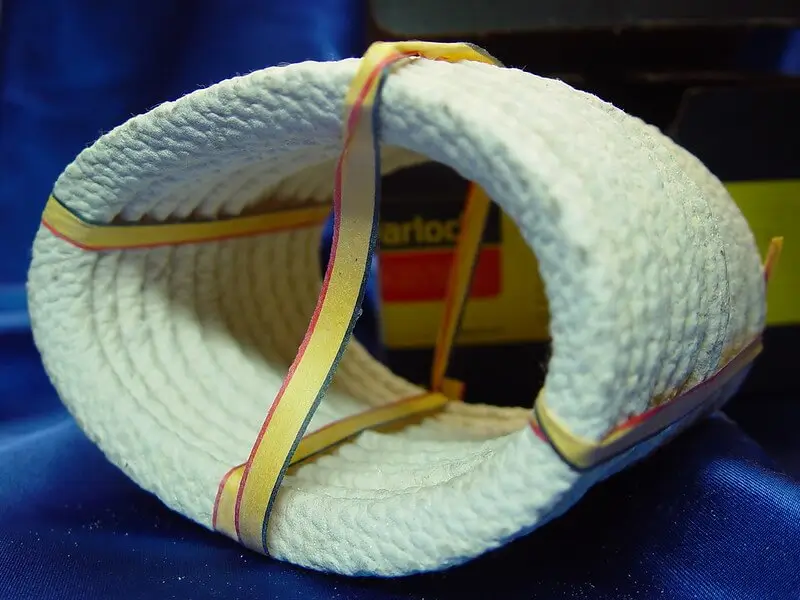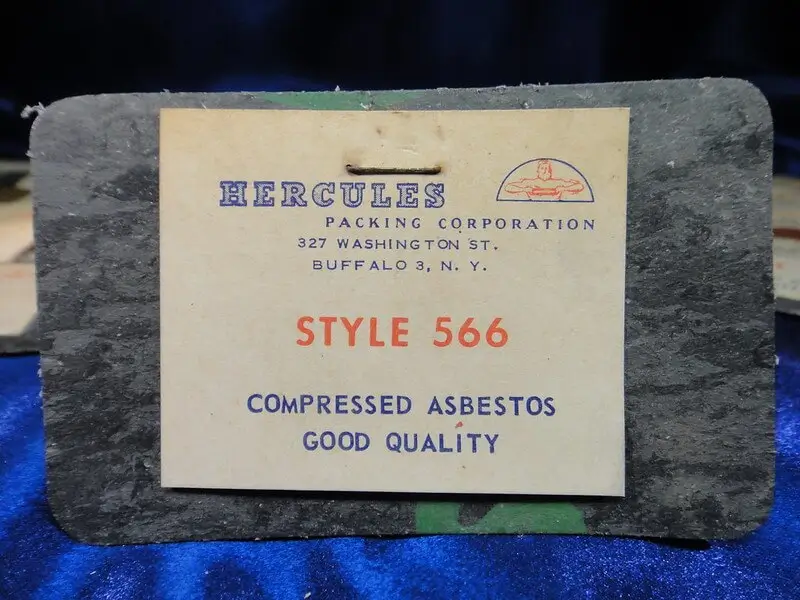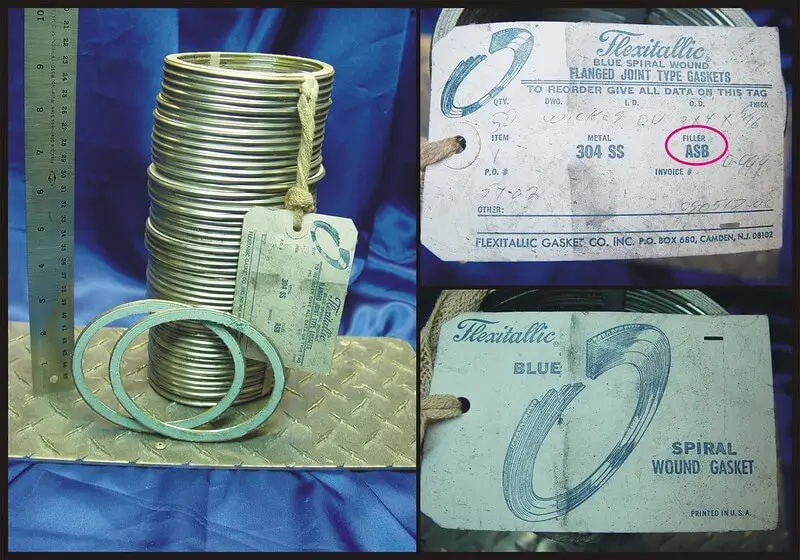Asbestos gaskets were once a staple in various industries due to their exceptional sealing capabilities and resistance to heat and chemicals. However, with the growing awareness of the severe health risks associated with asbestos exposure, the use of asbestos in gaskets has significantly declined.
This article delves into what asbestos gaskets are, the different types that were commonly used, the dangers and health risks they pose, and the current state of asbestos gasket usage and regulation.
What is an Asbestos Gasket?
An asbestos gasket is a sealing component made from asbestos fibers, often combined with other materials, designed to create a tight seal between pipes or machinery parts. These gaskets were widely used in engines, heavy industry, boilers, furnaces, and various other mechanical systems to prevent leaks and withstand high temperatures and harsh chemicals. The versatility, durability, and fire-resistant properties of asbestos made it an ideal material for gasket manufacturing until the health hazards became widely recognized.
Different Types of Asbestos Gaskets
Asbestos gaskets came in various forms, each tailored to specific applications and performance requirements. The most common types include:
1. Asbestos Rope Gaskets
Material: Soft rope woven from white asbestos fibers.
Properties:
- Highly flexible and adaptable to various sizes and shapes.
- Fireproof and capable of withstanding high temperatures.
Common Uses: Sealing doors of boilers, furnaces, ovens, and other industrial equipment.
Dangers: The loose binding of asbestos fibers makes rope gaskets particularly hazardous, as they can easily release fibers into the air when disturbed.

2. Asbestos Oval Gaskets
Material: Combination of soft asbestos material with a wire mesh core.
Properties:
- Maintains shape and provides extra strength.
- Resistant to high temperatures and chemicals.
Common Uses: Oil and natural gas production applications, where durability and resistance to harsh environments are crucial.
Dangers: Similar to rope gaskets, oval gaskets pose significant health risks during handling, installation, or damage, releasing harmful asbestos fibers.

3. Asbestos Sheet Gaskets (Sheet Packing)
Material: Pressed asbestos mixed with synthetic plastic fibers, forming a firm, cardboard-like sheet.
Properties:
- Easily mass-produced and cut into various shapes.
- Convenient for sealing standardized parts.
Common Uses: Sealing pipes, tanks, containers, and other mechanical components in factories, refineries, and power plants.
Dangers: Manual cutting and shaping of sheet gaskets can release asbestos fibers, increasing the risk of inhalation and related diseases.

4. Asbestos Spiral Wound Gaskets
Material: Concentric layers of asbestos and metal.
Properties:
- Extremely strong and capable of withstanding high pressures.
- Designed for permanent installation in high-stress environments.
Common Uses: Oil and natural gas production, power plants, and other industries requiring robust sealing solutions.
Dangers: Despite their strength, spiral wound gaskets leave nearly pure asbestos fibers exposed, posing a high risk of inhalation during installation, removal, or wear and tear.
Dangers and Health Risks of Asbestos Gaskets
Asbestos fibers are microscopic and can become airborne when asbestos-containing materials are disturbed, such as during cutting, scraping, or damage. Inhalation of these fibers can lead to severe and often fatal health conditions, including:
- Mesothelioma: A rare and aggressive cancer affecting the lining of the lungs, chest cavity, or abdomen.
- Lung Cancer: Can develop from prolonged asbestos exposure, especially among smokers.
- Ovarian Cancer: Emerging evidence links asbestos exposure to ovarian cancer.
- Laryngeal Cancer: Cancer of the larynx has been associated with asbestos fibers.
- Asbestosis: A chronic lung disease causing scarring of lung tissue, leading to severe respiratory issues.
- Benign Pleural Diseases: Includes pleuritis and pleural plaques, which affect the lining of the lungs and chest cavity.
Occupations at Risk
Workers in various industries face higher risks of asbestos exposure, including:
- Plumbers and Pipefitters: Regularly handle pipes sealed with asbestos gaskets.
- Auto Mechanics: Often work with older engines containing asbestos components.
- Factory and Construction Workers: Engage in manufacturing and building maintenance involving asbestos materials.
- Shipyard Workers and Navy Veterans: Exposure during shipbuilding and maintenance activities.
- Oil Refinery and Power Plant Workers: Utilize machinery and systems sealed with asbestos gaskets.
Long Latency Period
One of the most challenging aspects of asbestos-related diseases is their long latency period. Symptoms may not appear until 20 to 50 years after exposure, making early detection difficult and often resulting in advanced-stage diagnoses.
Historical Context and Regulation
Early Use and Popularity
Asbestos gaskets became widely used in the late 19th and early 20th centuries. Invented in 1899 by Austrian engineer Richard Klinger, asbestos gaskets quickly gained popularity due to their fire-resistant properties and ability to form tight seals in high-temperature and chemically aggressive environments. By 1912, the Flexitallic Gasket Company was selling the first spiral wound gasket, cementing asbestos as a key material in gasket manufacturing.
Decline and Regulation
Public awareness of the severe health risks associated with asbestos exposure grew significantly during the 1970s and 1980s. This led to stringent safety regulations and bans on the use of asbestos in many countries. In the United States, the Environmental Protection Agency (EPA) imposed strict controls, although some forms of asbestos, like chrysotile, are still legally imported for specific applications, including gasket manufacturing. However, many American gasket distributors now opt for asbestos-free alternatives to protect workers and consumers.
Transition to Safer Materials
Modern gasket manufacturers have largely replaced asbestos with safer, heat-resistant materials such as fiberglass, graphite, and various synthetic fibers. This transition has been crucial in reducing asbestos-related diseases and improving workplace safety across industries.
Safe Abatement and Removal
Removing asbestos gaskets requires specialized procedures to prevent fiber release and ensure safety:
- Professional Abatement: Only licensed professionals should handle asbestos removal due to the high risk of fiber release.
- Personal Protective Equipment (PPE): Workers must wear high-efficiency particulate air (HEPA) masks, disposable clothing, gloves, and eye protection.
- Containment: Creating a negative-pressure environment helps prevent asbestos fibers from spreading to other areas.
- Dampening Materials: Applying water to asbestos-containing materials before removal reduces airborne fiber release.
- Proper Disposal: Asbestos waste must be sealed in airtight containers or polythene sacks and disposed of according to state and local regulations, which often include labeling and secure transport.
Attempting DIY asbestos removal is highly dangerous and illegal in many jurisdictions due to the severe health risks and potential for environmental contamination.
Legal Options for Asbestos-Related Illnesses
Individuals exposed to asbestos through gaskets may be entitled to legal compensation. Key avenues include:
- Free Case Evaluations: Legal advocates offer free assessments to determine eligibility for compensation based on exposure and health conditions.
- Identifying Exposure: Attorneys can help investigate work history, pinpointing specific sources and types of asbestos exposure.
- Seeking Compensation: Claims can be filed against manufacturers if they are still in business, or against asbestos trust funds if the companies have gone bankrupt.
- Asbestos Trust Funds: Established to compensate victims from bankrupt companies, these funds provide a pathway to financial relief for affected individuals.
If you believe you have been exposed to asbestos, consulting with an experienced attorney can help navigate the complexities of legal claims and secure the compensation you deserve.
Conclusion
Asbestos gaskets played a pivotal role in various industries due to their exceptional sealing capabilities and resistance to extreme conditions. However, the severe health risks associated with asbestos exposure have led to their decline and replacement with safer materials. Understanding the types of asbestos gaskets, the dangers they pose, and the importance of proper abatement and legal recourse is crucial for workers, employers, and individuals who may have been exposed. Continued vigilance and adherence to safety regulations are essential in preventing asbestos-related diseases and ensuring a healthier future.
Disclaimer
This article is intended for informational purposes only and does not constitute legal or medical advice. If you believe you have been exposed to asbestos, please consult a qualified healthcare professional or attorney.

